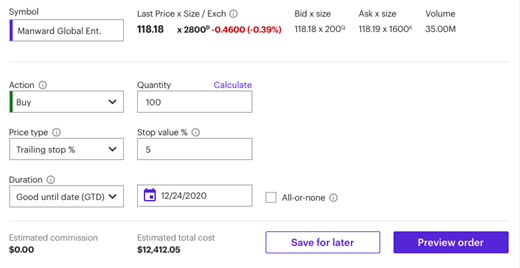Try This Simple Trick in a Market Crash to Boost Your Profits
Stock market sell-offs hurt.
These days they are swift and painful. But they don’t need to be.
We’ll let somebody else spew the same old tripe that sell-offs are buying opportunities. You already know that.
It’s been made quite clear in recent years that buying on dips is an easy way to boost your profits.
What few folks will tell you, though, is exactly when to buy.
How in the world do we know when we’ve reached a bottom?
How do we know when the rush of selling has stopped and buyers are back?
We don’t, of course. Nobody knows. But there’s a trick you can use that will help put the odds significantly in your favor.
You’ve probably already heard of it… but we bet you’ve never thought of using this trick quite this way.
[mw-adbox]
Rebound Confirmed
If you’ve hung around long enough, you’ve heard us mention trailing stops. They’re an ideal – and fairly popular – tool that helps to limit risk while maximizing reward.
But most folks don’t know trailing stops work on the buying side of things too.
If you’re the kind of person who drools over a market crash… you’re going to like this.
It’s pretty simple to understand and even simpler to put to use.
You see, when we look to buy into big market corrections, we don’t look to buy right at the bottom. It’d be nice, but trying to predict such things is dangerous. You’ll be wrong far more times than you’re right.
That’s why we look for some sort of confirmation signal.
You can use a host of technical indicators. We do.
But you can also use, you guessed it, a trailing stop. Again, they’re not just for selling.
Here’s how it works…
Break It Down, Andy
The key to understanding a trailing stop is to lock in on the idea of the “best price.” On the selling side of things, the best price is the stock’s highest price while you owned it.
But when you’re looking to buy, the best price is its lowest price.
For example, let’s say Manward Global Enterprises is selling for $100 per share… then we go and accidently insult some nut who gets offended and wants to “cancel” us.
Suddenly, our share price goes to $90… then $85… then $80.
We’re sweating… but you know our mission is too strong to be stopped. You decide you want to buy more shares while they’re cheap.
But you want to buy only when it’s clear we haven’t insulted anybody else.
You would do it by setting a trailing stop that automatically buys once the stock has rebounded by, let’s say, 5%. (You could use any percentage, but 5% is a strong rebound indicator after a sizable dip.)
As the stock falls, the trailing stop moves with it.
At $90, for instance, it would trigger a buy only if the stock rose back to $94.50.
If shares kept falling to $85, the trailing stop order would also drop… to $89.25.
If the stock hits $80, the buy price is $84.
But as shares start to rebound and the bulls come back, that low of $80 becomes the “best price.” It’s what controls the stop, which now doesn’t move.
So as the price rises to $81… then $82… then $83, the buy order remains at $84.
When the stock hits $84, it will have risen 5% from its lows and you’ll know it’s likely in the midst of a recovery. You can jump in and ride the stock all the way back to $100 per share… where we’ll likely say something to get ourselves in trouble again.
E.A.S.Y.
These sorts of trades are simple to make.
You can see what the trade would look like right here in an E-Trade account…

Again… nice and simple.
Just select the trailing stop percentage, enter the number you’re comfortable with and then be sure to set the trade’s duration to “good ’til canceled” (GTC) or set an appropriate date a few weeks out. (It’s unlikely you’ll want to keep the order for only a day or two.)
And remember, this is the sort of entry you want to make when the market is in a bit of a panic. It’s not for everyday trades.
It’s an ideal way to push emotion out of your trading and enter good stocks at good prices, when they’re likely on their way back up.
Try it…
It’ll give you a good reason to look forward to a nasty correction.
Do market crashes make you fearful… or greedy? Tell us about it at mailbag@manwardpress.com.
About Andy Snyder
Andy Snyder is the founder of Manward Press. An American author, investor and serial entrepreneur, Andy cut his teeth at an esteemed financial firm with nearly $100 billion in assets under management. In the years that have followed, he’s become sought after for his outspoken market commentary.
Andy and his ideas have been featured on Fox News, on countless radio stations, and in numerous print and online outlets. He’s been a keynote speaker and panelist at events all over the world – from four-star ballrooms to Capitol hearing rooms – and has rubbed shoulders with lawmakers, lobbyists and Washington insiders. He’s had lunch with John McCain… fished with America’s largest landowner… and even appeared on the Christmas card of one of Hollywood’s top producers.
Today, Andy’s dissident thoughts on life, Liberty and investing can be found in his popular e-letter, Manward Financial Digest, as well as in the pages of Manward Letter. He also is at the helms of the award-winning VIP Trading Research Services Alpha Money Flow and Venture Fortunes. Andy resides on 40 bucolic acres in rural Pennsylvania with his wife, children and a steadily growing flock of sheep.






